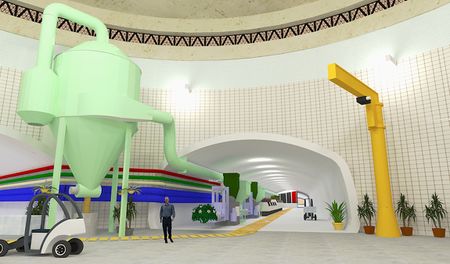Production
Production spaces and facilities for a Mars settlement may occupy a large part of the available space in a colony. Production facilities including Agricultural, Manufacturing, Mineral extraction, Craft production and even, eventually, Entertainment. Products from the production facilities can be used on Mars or traded with Earth. Production facilities house processes, many of which will use local in situ resources.
Production facilities will be the main users of energy on Mars; Propellant production and agricultural production in particular. Maintenance facilities will also be required to support the production activities, as well as research laboratories.
Contents
Agricultural production and facilities
Until terraforming or genetic manipulation provides the possibility of plant production outside of an artificial environment, agriculture will require greenhouses, either naturally or artificially illuminated. Agricultural production will also include hydroponics, aquaponics, aeroponics and possibly animal husbandry. Part of the food for a colony might come from biological reactors, possibly sidestepping much of the need for agriculture.
Mineral and water extraction facilities
Mining will require facilities in addition to the mines themselves. Crushing equipment, garages, stores and laboratories will be required on site. Loading stations and transportation equipment will also be required.
Atmospheric extraction facilities
As an element of propellant production and as a source for most of the carbon and atmosphere for the colony, atmospheric processing is an important part of a settlement production facilities. The first stages of atmospheric processing may be exterior, to profit from the cooling available from the cold martian outdoors. Fans, compressors and coolers will need to dissipate large amounts of heat.
Propellant production facilities
In the early days of the Martian settlement propellant production will be one of the main thrusts of development. IN-situ resource utilization is an obligation if the transportation costs are to be set to a level that can make the settlement possible. Eventually, as the ratio of settlers to immigrants goes up, the amount of locally produced goods goes up and the required importations go down, propellant production will become less central to the settlement economy.
Electrolysis of water is the basis of all the propellant production schemes. In particular, now that it has been discovered that there are large quantities of water on Mars, in-situ propellant production is part of every Mars colonization or exploration plan. For most of these plans the Sabatier process is used to transform CO2 extracted from the atmosphere and water from the Martian regolith into Methane and oxygen.
Manufacturing production and facilities
Manufacturing on Mars will be similar to manufacturing on Earth. However, there will be no heritage infrastructure that needs to be preserved or supported. The most modern techniques such as 3D additive manufacturing may be used extensively.
Heat recovery, rather than burning hydrocarbons, will be used as much as possible for heating and most heating processes will be electrical. Steel, glass, ceramics, concrete and aluminium may be primary products. All manner of manufactured goods, equipment, clothing, utensils and containers will be manufactured as equipment is imported or built on site and speciality manufacturing comes on line.
Entertainment production and facilities
Mars will need a radio and a TV station. Locally produced shows will be in demand as soon as they are possible.











